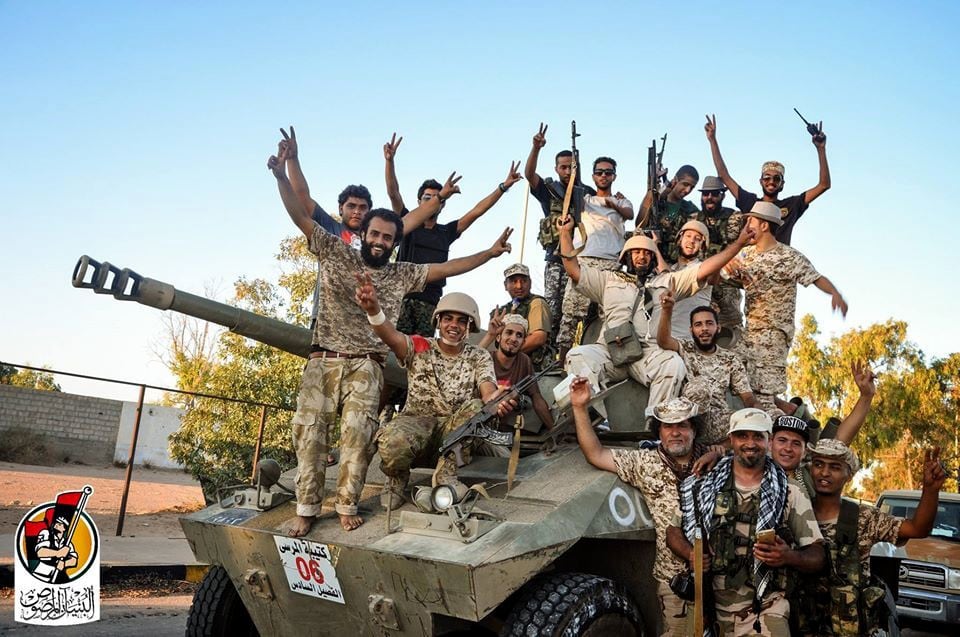WASHINGTON — The Pentagon has expanded the criteria for the Global War on Terrorism Expeditionary medal to include the U.S. campaign against ISIS in Libya.
The geographic criteria for the medal highlights the extent of the American operation to remove ISIS from the Libyan city of Sirte.
The U.S. military operation to liberate Sirte from ISIS was conducted from Aug. 1, 2016 until Dec. 19, 2016, and authorized under the Obama administration. The operation was dubbed Operation Odyssey Lightning.
Service members who participated in Operation Odyssey Lightning from Aug. 1 to Dec.19, 2016 — the date Libya ended operations in Sirte, are eligible for the Global War on Terrorism Expeditionary medal.
Odyssey Lightning was launched with the support of Libyan Government of National Accord (GNA) — the current U.N.- and U.S.-backed government that came into existence after extensive political negotiations in December 2015.
The operation’s primary objective was limited in scope to the removal of ISIS in Sirte, according to officials at U.S. Africa Command. However, the criteria for the GWOT Expeditionary medal for the Libya operation includes Algeria, Chad, Egypt, France, Greece, Italy, Libya, Niger, Spain, Tunisia and the Mediterranean Sea from the Straits of Gibraltar.
Despite the limited scope of the operation to liberate Sirte, the size and scale of U.S. air support assets needed to assist Libyan ground forces combating ISIS was quite large.
The expansive geographic criteria for the GWOT-E in Odyssey Lightning is a result of regional and offshore U.S. supporting assets to include air, intelligence, strike aircraft and surveillance assets, according to Maj. Audricia Harris, a spokesperson for the Pentagon.
"At any given time there are approximately 5,000-6,000 U.S. personnel on the continent [Africa]," said Robyn Mack, a spokesperson for AFRICOM. Most of those forces operate out Camp Lemonnier in Djibouti.
The prosecution of U.S. operation against ISIS in Libya was similar in design to Operation Inherent Resolve, where a U.S. led coalition is battling ISIS in Syria and Iraq.
The U.S. has thousands of U.S. troops and supporting air assets outside of Iraq and Syria supporting operations against ISIS to include Kuwait, Qatar, Turkey, Jordan, and Bahrain, according to Harris. Overall, U.S. ground forces in Syria are small in comparison to the tens of thousands of support personnel and air assets outside Iraq and Syria with roughly 5,000 troops in Iraq and a force manning level set at 500 in Syria.
However, the expansive criteria for the Odyssey Lightning campaign also highlights an expanding role of U.S. forces in north Africa and ISIS’ reach in the region, according to Emily Estelle, an expert covering Libya at the American Enterprise Institute.
It "reflects AFRICOM’s recognition of the extent of ISIS’s network in northern Africa. Sirte served as ISIS’s hub in Africa, from which the group both recruited militants and sent fighters to neighboring states in the Maghreb and the Sahel," Estelle told Military Times.
The U.S. footprint in north Africa has been steadily growing over the last several years because of threats posed by a host of non-state actors like ISIS, Boko-Haram, and al-Qaida offshoots operating in areas of ungoverned spaces.
"We [AFRICOM] maintain several enduring locations such as Garoua, Cameroon; Chebelley, Djibouti; and Agadez, Niger on the African continent which give the United States options in the event of crisis and enable partner capacity building," Mack told Military Times.
In Niger, for instance, the U.S. built a $100 million dollar drone base back in September, primarily to keep tabs on movement of Boko-Haram, according to a report by Reuters.
"This base is meant to serve ISR needs across the Sahel and Lake Chad Basin, and I expect the Maghreb as well," Estelle said. "The benefit to [Operation Odyssey Lightning] OOL would be tracking any southward movement of ISIS personnel leaving Sirte."
As U.S. airpower pushed ISIS fighters out of Sirte, the fighters attempted to flee the city and Libya. "I expect that AFRICOM dedicated ISR assets from Niger to keep track of ISIS fighters attempting to leave Libya to the south," Estelle explained.
In Chad, the U.S. has a strong relationship with Chadian forces, and it is likely the U.S. is operating small training posts and forward operating bases to monitor the movement of militants in the region, Estelle said.
Algeria has a more tenuous relationship with the U.S., but the U.S. has provided Algeria with access to U.S. intelligence to combat al-Qaida in the Maghreb, or AQIM. In turn, Algeria has opened its airspace to U.S. and French air assets, Estelle said.
It is not entirely clear if the U.S. has ever conducted airstrikes or operations outside of Libya in support of Odyssey Lightning. When asked by Military Times, a spokesperson for AFRICOM responded that "a small number of U.S. forces have gone in and out of Libya to exchange information with local forces and they will continue to do so as we strengthen the fight against ISIS and other terrorist organizations."
Much like the war against ISIS in Iraq and Syria, the U.S. brought to bear the force of tens thousands of U.S. ground forces without having to put a large footprint on the ground in Libya. Outside air assets and small surveillance outposts throughout north Africa and the Sahel assisted in the operation to liberate the city of Sirte from ISIS.
Odyssey Lightning was temporarily reinstated at the request of the Libyan government on Jan. 18, 2017 to strike a couple of ISIS camps outside of Sirte. "The ISIS terrorists targeted included individuals who fled to the remote desert camps from Sirte in order or reorganize," Mack said.
Shawn Snow is the senior reporter for Marine Corps Times and a Marine Corps veteran.
